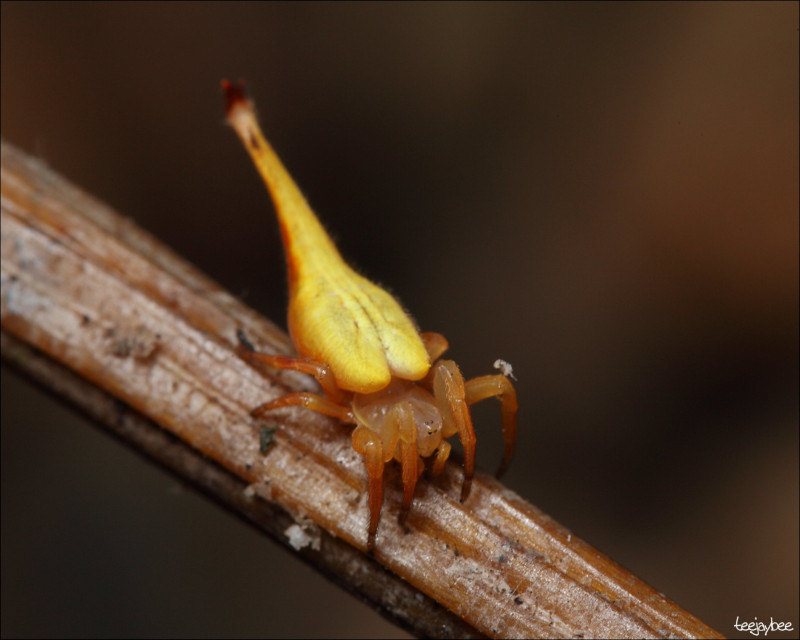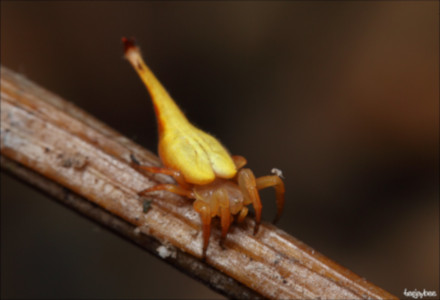
Scorpion-Tailed Spider Facts
- The attention-grabbing term of Scorpion-Tailed Spider fits this amazing arthropod. Although riveting, it’s not the only name applied to it, though. That’s because it’s also known by such terms as scorpion orb weaver and simply the tailed spider.
- Its official scientific name, meanwhile, remains far more difficult to pronounce. That’s because arachnologists know it as the Arachnua higginsi. Regardless of which term one applies to it though, it’s an incredible species, and remarkably evolved.
- The highly respected German entomologist and arachnologist, Ludwig Carl Christian Koch, made the first official notice of it. That original recognition of the arachnid as a separate and distinct species took place due to his efforts in the year 1872.
- Fortunately, the amazing Scorpion-Tailed Spider appears to be maintaining a population base that’s both sufficient and stable. This further seems to hold true throughout the entirety of its range. The IUCN, therefore, has no listing for the animal.
- This fascinating species nevertheless faces the same potential threats that most, if not all, living things on earth now do. These come in many forms, of course. Chief among these would be habitat loss and the ongoing effects of climate change.
Related Articles
Scorpion-Tailed Spider Physical Description
The magnificent Scorpion-Tailed Spider actually deserves note for two different physical reasons. The first, somewhat surprisingly, involves its simple physical size. That’s due to the fact that this amazing arachnid evolved an impressive degree of sexual dimorphism.
More specifically, in its particular case, the females develop as significantly larger in terms of body size. The length of the body of the female averages about 0.63 in (16 mm). That of the tiny male, however, only reaches an average length of roughly 0.08 in (2 mm).
The astonishing tail, though, remains its most distinctive physical attribute. This also represents another form of gender-based physical difference. That’s because only the females develop this body part. This appendage increases in size with each molting.
Though different in terms of size and the unique appendage, the two genders display identical patterns of color. This varies extensively among adult individuals, however. Typically, though, this ranges from as light as beige to as dark as shades of brown and black.
Another color pattern further appears among a small percentage of adults. That’s the presence of a bright red or yellow patch on the abdomen. Juveniles of the impressive Scorpion-Tailed Spider, however, frequently display even brighter colors than adults.
- Kingdom: Animalia
- Phylum: Arthropoda
- Class: Arachnida
- Order: Araneae
- Family: Araneidae
- Genus: Arachnura
- Species: A. higginsi
Scorpion-Tailed Spider Distribution, Habitat, and Ecology
The fascinating arachnid known as the Scorpion-Tailed Spider has a very specific habitat range. That’s because it evolved as native to only a limited portion of the globe. It’s also a region well known for the astounding diversity of life, including spiders.
This holds true due to the fact that it evolved as endemic to a portion of the continent of Australia. Even within that country, though, its range remains restricted. In point of fact, it’s only known to live in the southern continental sections, and Tasmania.
On the other hand, within that area it appears to be widespread. That’s due to the fact that it displays a remarkable versatility in terms of its habitat preferences. The natural marvel seems comfortable in virtually any form of bushland, even gardens on occasion.
The web of this particular arachnid typically appears built close to the ground. Surprisingly, this appears in either a vertical, angled, or even horizontal position. During the day, the spider sits patiently in or near the center of the web. Here, it patiently awaits its prey.
Most commonly, the prey of the Scorpion-Tailed Spider consists of small insects, like most of its kin. The tail, though distinctive, remains harmless, and plays no role in hunting. It does, however, move it in a manner similar to a scorpion, as a deterrent to predators.
Species Sharing Its Range
Check out our other articles on 4 Wondrous United States Waterfalls, Bonnethead Shark, Caverns of Sonora, Inaccessible Island Rail, Giant Girdled Lizard, Shameplant

